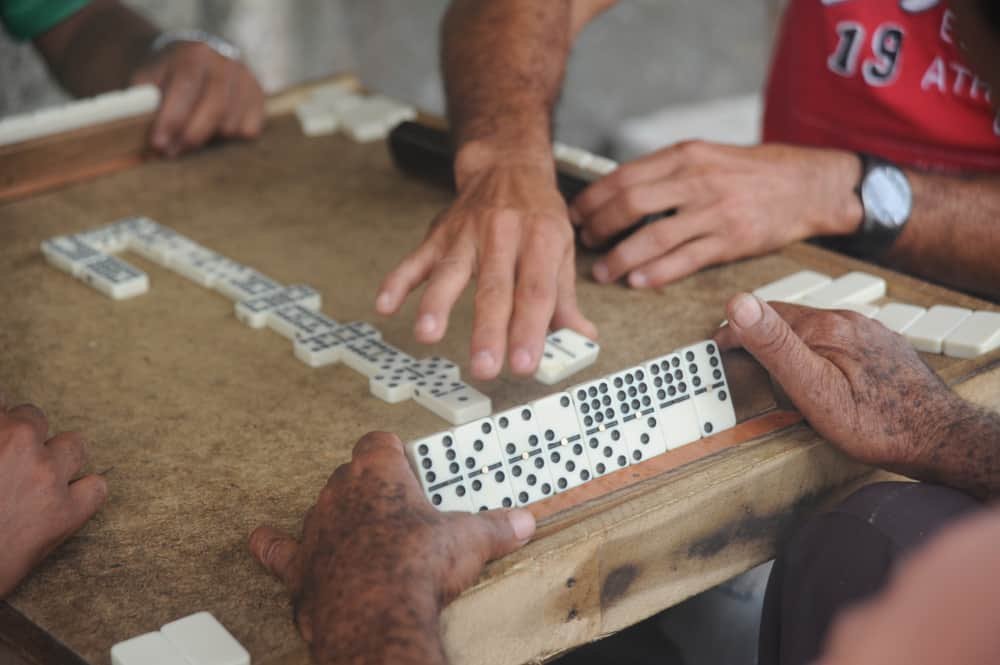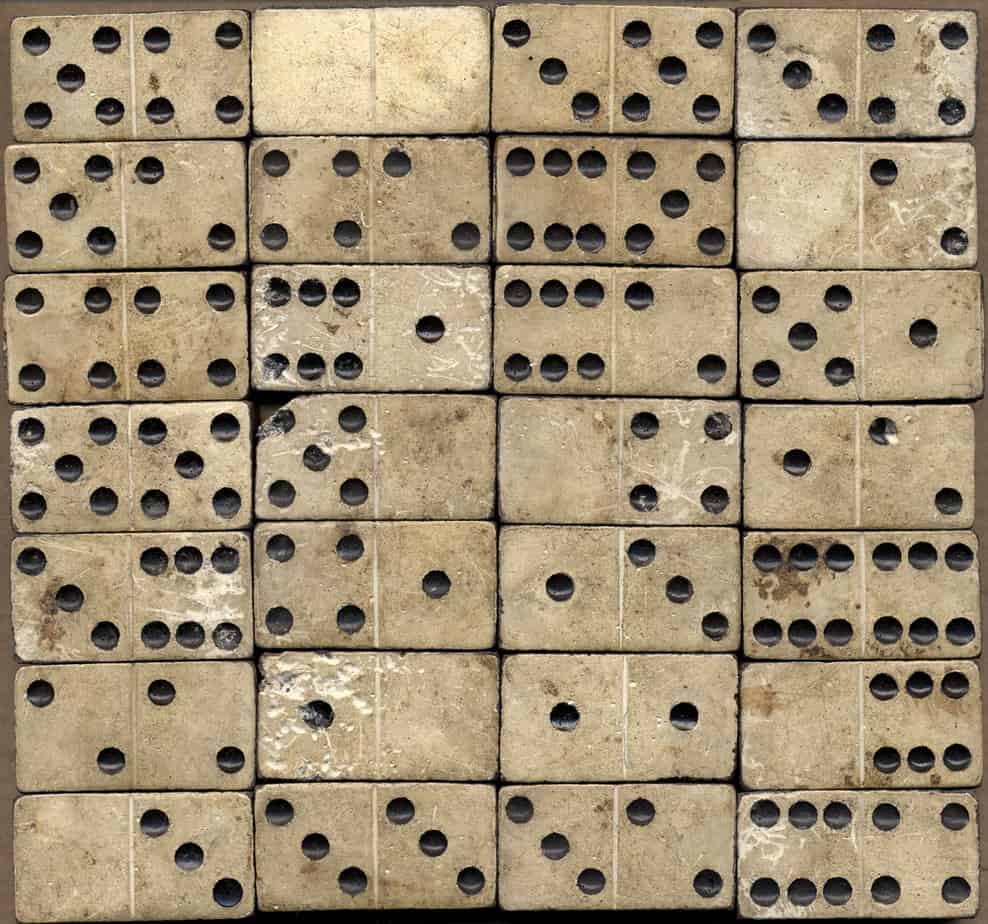Last Updated on January 7, 2024 by Gamesver Team and JC Franco

Surely everyone in the world is familiar with the game of dominoes! Well, maybe not everyone, but many are and have enjoyed playing it since childhood. Right now, you may be asking yourself, ‘what is the history of dominoes’? Well, let’s find out…
The earliest known reference to dominoes dates back to the Yuan Dynasty in China in the 1200s AD. The modern game appeared in Italy in the 18th century. Yet, it’s still a mystery how the Chinese version of dominoes developed into the actual game; it’s believed Italian missionaries brought the game to Europe from China .
Now that you know a little bit about the history of dominoes, let’s explore this fascinating game in more detail. We will discuss how it originated, how to play it, and what the rules. So, if you’re ready to learn all you need to know about the fascinating game of dominoes, then let’s get started!
Dominoes: The History
China
As mentioned above, the oldest known form of the game originated in China during the Yuan Dynasty. A man named Zhou Mi wrote about it in his text entitled Former Events in Wulin somewhere between 1232 and 1298. In it, he mentioned both the ‘

Zhang Pu (1602-1641) also wrote about the game in the Encyclopedia of a Myriad of Treasures stating that it involved the laying out dominoes or ‘
From China to Europe
When the game arrived in Europe in the 18th century, it was first seen in Italy (Venice and Naples). This modern version saw the traditional Chinese game change to better suit Western culture. European game sets contain 7 additional dominoes, 6 of which represent the values attained from throwing 1 die with the other half of the tile left blank. The 7th piece represents the blank or 0-0 combination.
After arriving in Italy, the game made its way to France, where it became quite popular. Then, in the late 18th century, Dominoes appeared in Britain; it’s believed French war prisoners brought the game with them.

Dominoes the game was unknown in Europe until the 18th century. One theory suggests it developed into its modern form somewhere in the Dominican Republic first. The dark markings on the white faces apparently reminded people of masquerade ball masks (the eyeholes were often called ‘dominoes’). Thus, giving the game pieces their current name.
Another theory implies that the game got its name from the French word “Domino,” which refers to the black and white hoods that were used by French Christian priests during the winter.
Today
Nowadays, different versions of the game Dominoes are played all over the globe. Although it originated in China, the game is quite popular in Latin America, especially in the Caribbean region.

Descendants of dice
Dominoes are often called the descendants of dice. The original Chinese dominoes contained 2 ends which illustrated 1 of the possible 21 combinations that take place when the 2 dice are thrown. Modern (western) dominoes, on the other hand, have blank ends as well, which account for the 28 pieces.
How Do You Play Dominoes?
The most common way to play dominoes is often referred to as ‘Straight Dominoes’. All you need is a set of tiles and a few friends to join in the fun! The eight necessary steps to play (with two to four people) include the following:
Step One
Set-up the game by shuffling the dominoes face down on a hard surface such as a table. Have each player choose one tile. The player that has the highest double goes first. If a double wasn’t drawn, then the person with the heaviest tile (or most black dots, also known as ‘pips’) goes first.
Step Two
Get each player to choose seven dominoes from anywhere in the shuffled pile. After a tile is picked, it cannot be put back into the pile. Place the seven dominoes in front of you so only you can see them.
Step Three
To begin the round, the person who drew first puts down any tile he/she wants. It’s a good idea to lay a tile you know you can match and build off of when it’s your turn again.
Step Four
Going counter-clockwise around the table, continue laying down tiles to build off of. The tile must have a side that matches the open end of any previously played piece. Continue playing until one person no longer has any tiles left.

Step Five
If you cannot play a tile, pick a new one up from the pile. If this new tile matches something on the already on the table, play it. If not, add it to your hand, and the next player takes his/her turn.
Step Six
The round is over (and won) when a player no longer has any tiles left in his/her hand. This should take at least seven turns, or more if all players end up picking up extra tiles from the draw pile.
Step Seven
Following the round, each player must tally their score by adding up the total number of pips on the tiles that are left in their hand, or not played. On a sheet of paper, add those numbers to the winner’s score.
Step Eight
Continue the game with a second round played the same way as the first. Play until someone reaches one hundred points, thus winning the game
What are the Basic Rules of Dominoes?
The basic rules of dominoes fall into two main categories. These include blocking games and scoring games. The four key points include the following:

- In blocking games, the object is to completely empty one’s hand while at the same time, blocking other player’s moves.
- In scoring games, the object is to be the first player to get one hundred points. Instead of setting up your next move (or blocking your opponent’s move), getting the most points is the principal objective.
- Hector’s Rules (a popular version in Singapore) allows a person to play double tiles on his/her opponent’s previous hand, which results in a bonus play (of an additional tile) immediately following the double tile placement
.
- If a player lays down all tiles on a single turn, the game is ruled a tie.
How Many Types of Dominoes Games are there?
There are many variations of dominoes being played today. These mostly include layout games (such as blocking games and scoring games). Let’s take a closer look at a few of these variations below.
Blocking Games
Basic Trains
This variation is usually played with double-nine or double-twelve sets. The number of tiles drawn from the pile depends on both the number of players as well as the size of the set. If a player doesn’t end up with a double, then the tiles must be reshuffled.
The game begins with each person playing a double. This starts a private line or train. As the game continues, a player must add a tile to his/her own train. If this is not possible, then he/she forfeits a turn. The first person to empty their hand is the winner (and adds 120 points to his/her score as well as 5 for each tile that still remains in his/her opponent’s hand).
Spinner
This version was created by James and Edna Graham and uses the standard double 9 set with an additional eleven tiles. These tiles represent various combinations of the typical values 0-9 but with the added ‘spinner’ and ‘double spinner’ symbols similar to a wild card.
The game starts with each person choosing either 14 tiles (if there are only two players) or 7 tiles (if there are three or more players). It begins with the double 9 or
Scoring Games
Bergen
This version does not include spinners; therefore, the line of play does not branch off. A person scores 2 points by playing a tile that matches the values appearing at both ends of the line and 3 points for a double. An additional 2 points are awarded to the player who empties his/her hand, thus ending the game.
Muggins
This variation is also known as All Fives or Fives Up. Players can score on each turn if the total pip count at the end of each line of play is divisible by 5. This is in addition to the final scoring at the end of the game. The first double (or all doubles depending on which variant is being played) can also be used as a spinner, enabling the line of play to branch off and continue.
In Summary

The game of dominoes originated in China in the 12th or 13th century long before its arrival in Italy around the 18th century. This European version is what gave rise to the modern version we all know today. There are many variations of the game that are based on the two main types, including blocking and scoring games. Why not get the family over for a fun game of dominoes tonight! Good luck!

